Tom's Hardware Verdict
The TRX40 Aorus Master’s shorter voltage regulator means it will fit more case and cooler combos. But its added depth means it will fit fewer ATX (but all EATX) cases. If this board plays well with the rest of our components and you like lots of expansion slots and M.2, it's well worth considering.
Pros
- +
Excellent DRAM overclocking
- +
Better efficiency
- +
More onboard PCIe and M.2 slots than competition
- +
More component clearance around voltage regulator
Cons
- -
Mediocre CPU overclocking and voltage regulator cooling
- -
Oversized (10.6”) depth checking for case clearance
Why you can trust Tom's Hardware
The platform diagram for AMD's new Threadripper platform might have stolen the show in our first TRX40 motherboard review (ASRock's TRX40 Taichi), but Gigabyte took a different tact in the design of its $499 TRX40 Aorus Master, which shows most noticeably in its four PCIe x16-length expansion slot and lower-profile (27mm) voltage regulator heatsink. That last bit’s important because many cases are designed to let the fans of a top-mounted liquid cooler hang below the upper edge of the motherboard.
Specifications
| Socket | sTRX4 |
|---|---|
| Chipset | AMD TRX40 |
| Form Factor | "EATX" (10.6"-deep) |
| Voltage Regulator | 16 Phases (+3) |
| Video Ports | ✗ |
| USB Ports | 10Gb/s: (5) Type A, (1) Type-C, (2) USB 2.0 |
| Network Jacks | 5GbE, Gigabit Ethernet, (2) Wi-Fi Antenna |
| Audio Jacks | (5) Analog, (1) Digital Out |
| Legacy Ports/Jacks | ✗ |
| Other Ports/Jack | Q-Flash, CLR_CMOS buttons |
| PCIe x16 | (4) v4.0 (x16/x8/x16/x8) |
| PCIe x8 | ✗ |
| PCIe x4 | ✗ |
| PCIe x1 | (1) v4.0 |
| CrossFire/SLI | 3x / 3x |
| DIMM slots | (8) DDR4 |
| M.2 slots | (3) PCIe 4.0 x4 / SATA |
| U.2 Ports | ✗ |
| SATA Ports | (8) SATA 6Gb/s |
| USB Headers | (1) v3.x Gen2, (2) v3.x Gen1, (2) v2.0 |
| Fan Headers | (8) 4-Pin |
| Legacy Interfaces | System (Beep-code) Speaker |
| Other Interfaces | FP-Audio, (2) ARGB LED, (2) RGB LED, (2) Thermistor, Noise Sensor, Thunderbolt AIC |
| Diagnostics Panel | Numeric |
| Internal Button/Switch | Power, Reset / BIOS mode, IC selector |
| SATA Controllers | Integrated (0/1/10) |
| Ethernet Controllers | Aquantia AQC111C PCIe, WGI211AT PCIe |
| Wi-Fi / Bluetooth | Intel AX200 802.11ax (2.4 Gb/s) / BT 5.0 Combo |
| USB Controllers | ✗ |
| HD Audio Codec | ALC1220 |
| DDL/DTS Connect | DTS Connect |
| Warranty | 3 Years |
Other than the above-mentioned changes, the feature sets look remarkably similar between Gigabyte’s Aorus Master and the ASRock TRX40 board that we reviewed previously. The same 2.5Gb/1Gb Ethernet duo and Wi-Fi 6 controllers are used, and both boards even have the same number of RGB and ARGB (digitally-addressable RGB) headers. Moreover, Gigabyte’s layout appears optimized for a PCIe-to-M.2 adapter card in its second x16-length slot, but there’s plenty more to discuss there since the second and fourth slots have eight lanes rather than sixteen.
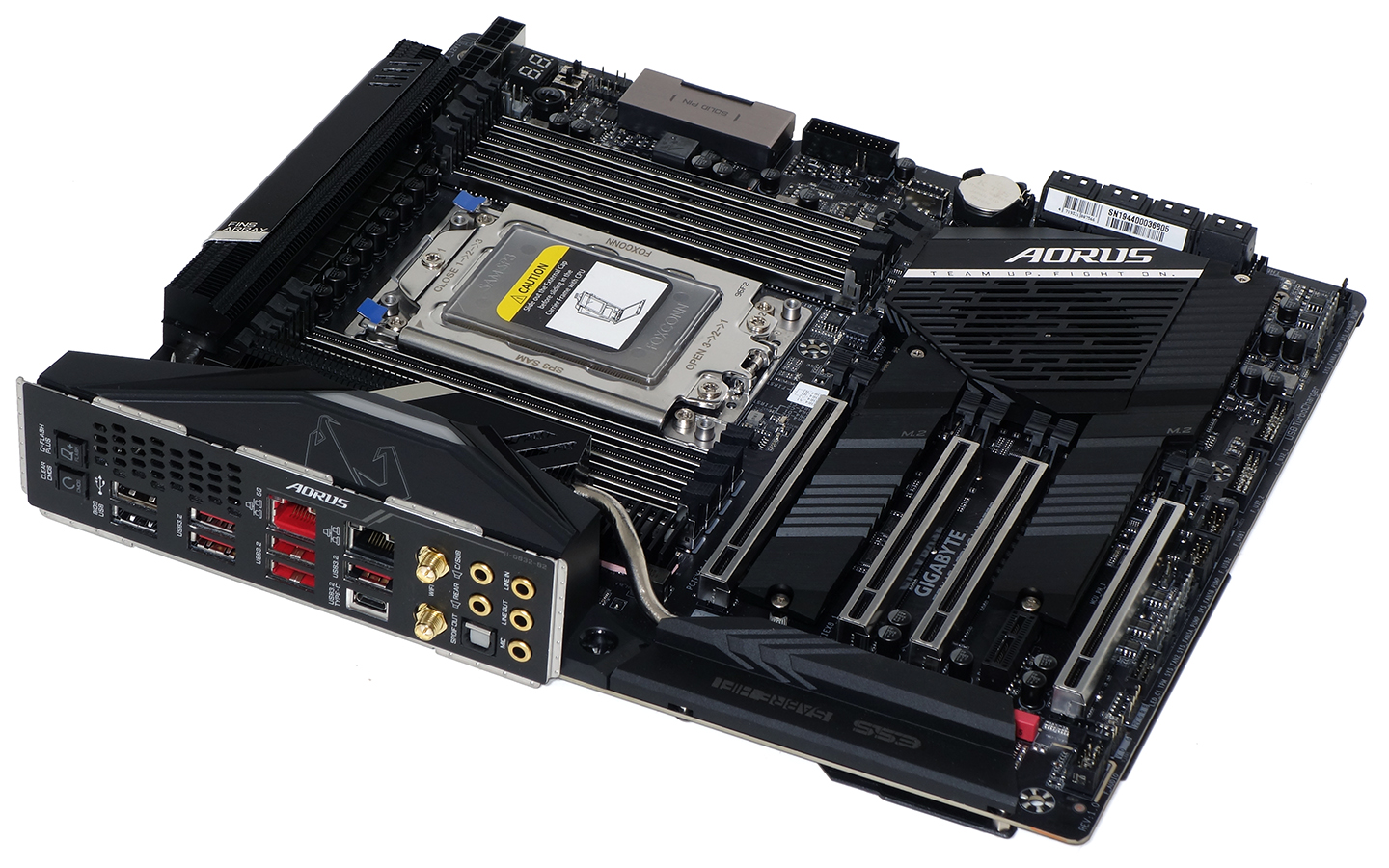
A closer look at the I/O panel reveals a few of the less-obvious differences, such as the lack of 2x2-mode for the USB 3.2 Gen2 Type-C connector. Gigabyte’s board gains a couple USB ports, and while many readers will scoff at those being of the ancient 2.0 variety, we can’t think of a better place to connect our keyboard and mouse. And while the competing board has a firmware flash mode button, the Aorus Master adds a handy CLR_CMOS button to help overclockers recover from a bad setting, without digging into their system to pull the battery.
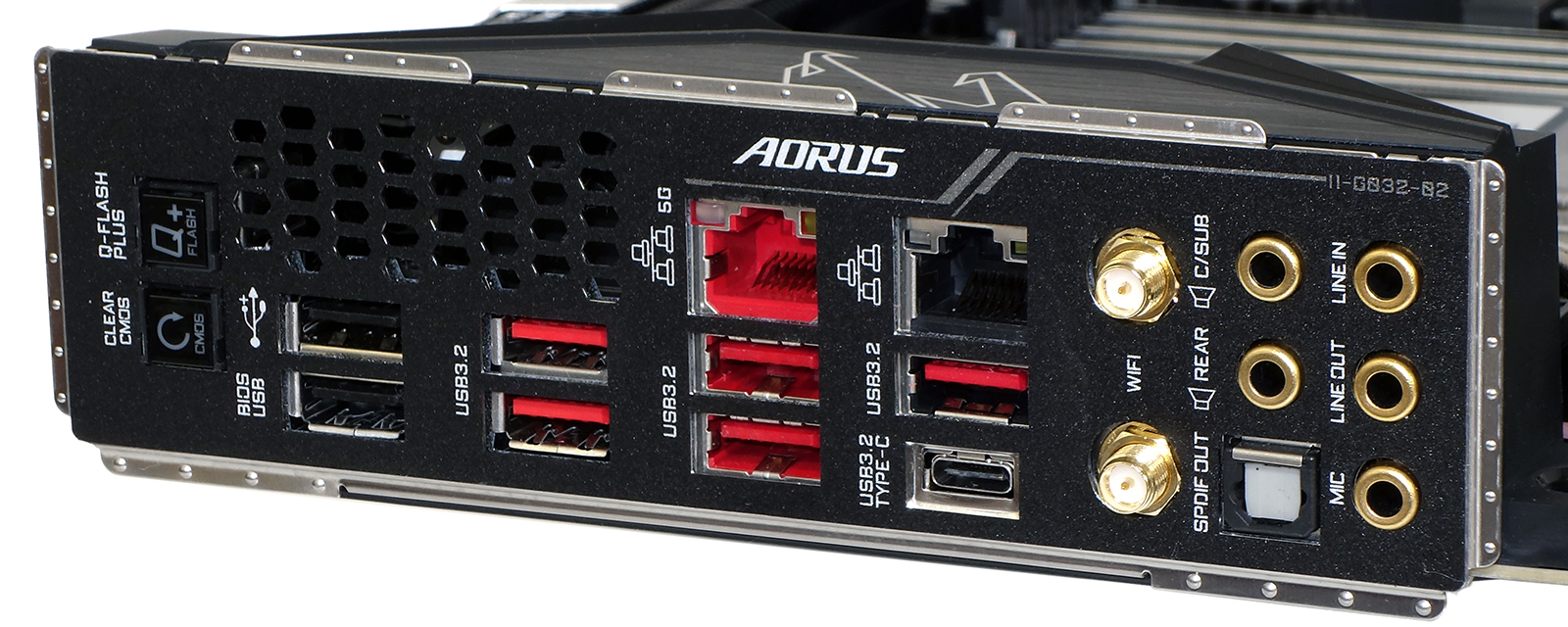
The TRX40 Aorus Master’s heat pipe leads down from its 16-by-70A voltage regulator to its audio codecs, adding a second set of fins between the rear DIMM bank and RGB-decorated I/O panel cover. That heat pipe path meant that designers had to use an actual aluminum heat sink over its audio section, rather than the typical plastic facade.
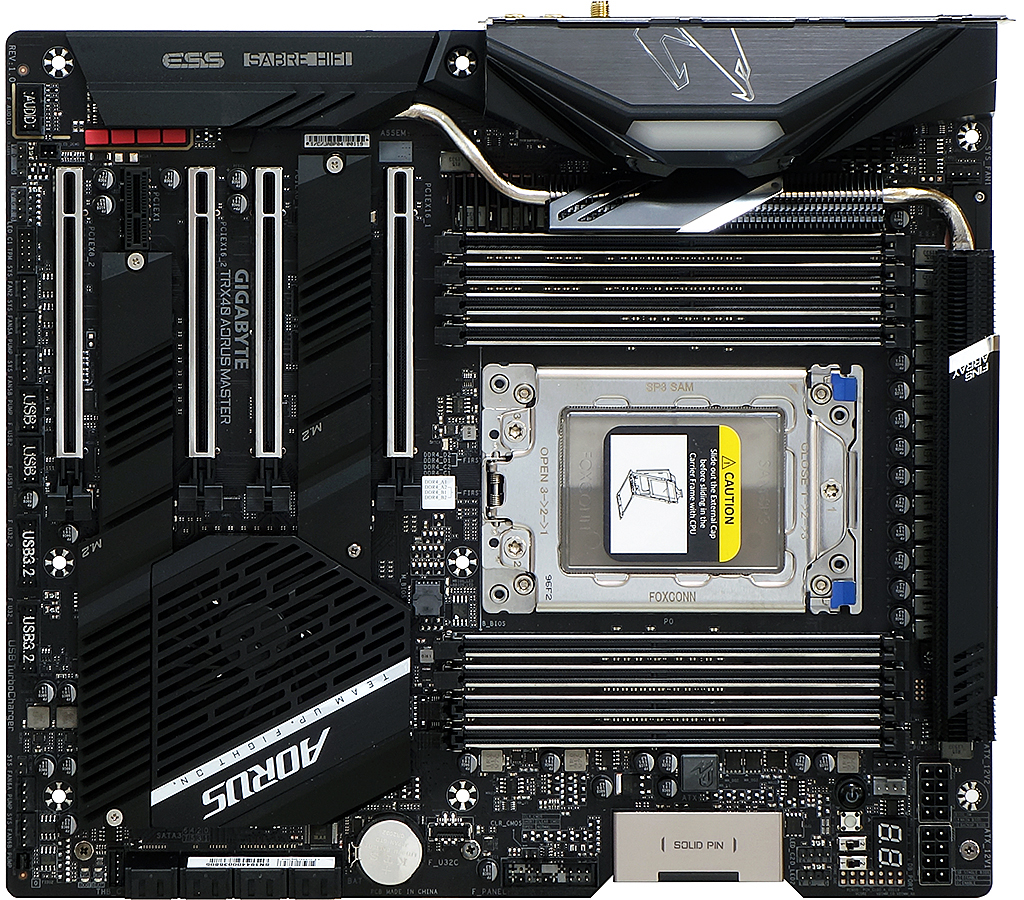
The location of that long voltage regulator dictated that DIMM placement would encroach upon PCIe slot space, so that the top x16 slot aligns to the case’s second card slot. Gigabyte still makes it possible to install two triple-slot cards in the first and third slots, and configures both of those with sixteen pathways. Since eight of the CPU’s 64 onboard PCIe lanes are dedicated as a chipset link and eight to M.2 drives, that leaves sixteen pathways split between the second and bottom slots at eight lanes per slot.
Because the second and bottom slots are wired as x8, a passive PCIe x16 to M.2 adapter such as the one included in ASRock’s board wouldn’t support all four M.2 slots. Gigabyte has an active adapter that could switch the drives from two x4 to four x2, but it’s not included in the box with this board.

You might not even need those eight-lane slots for storage, given that the Aorus Master has three onboard M.2 slots. These are accessible via two separate M.2 covers that don’t involve the chipset’s fan shroud, making access of the top slot easier compared to the competing ASRock board.
Get Tom's Hardware's best news and in-depth reviews, straight to your inbox.
Below all of those slots, the TRX40 Aorus Master’s bottom edge is filled with headers for front-panel audio, ARGB and RGB, a Trusted Platform Module, five (of eight) fans, two dual-port USB 2.0 headers, two front-panel USB 3.0, and an internal noise level microphone for fan tuning. A Thunderbolt add-in-card header is found just above these, adjacent to the board’s eight forward-facing SATA ports.
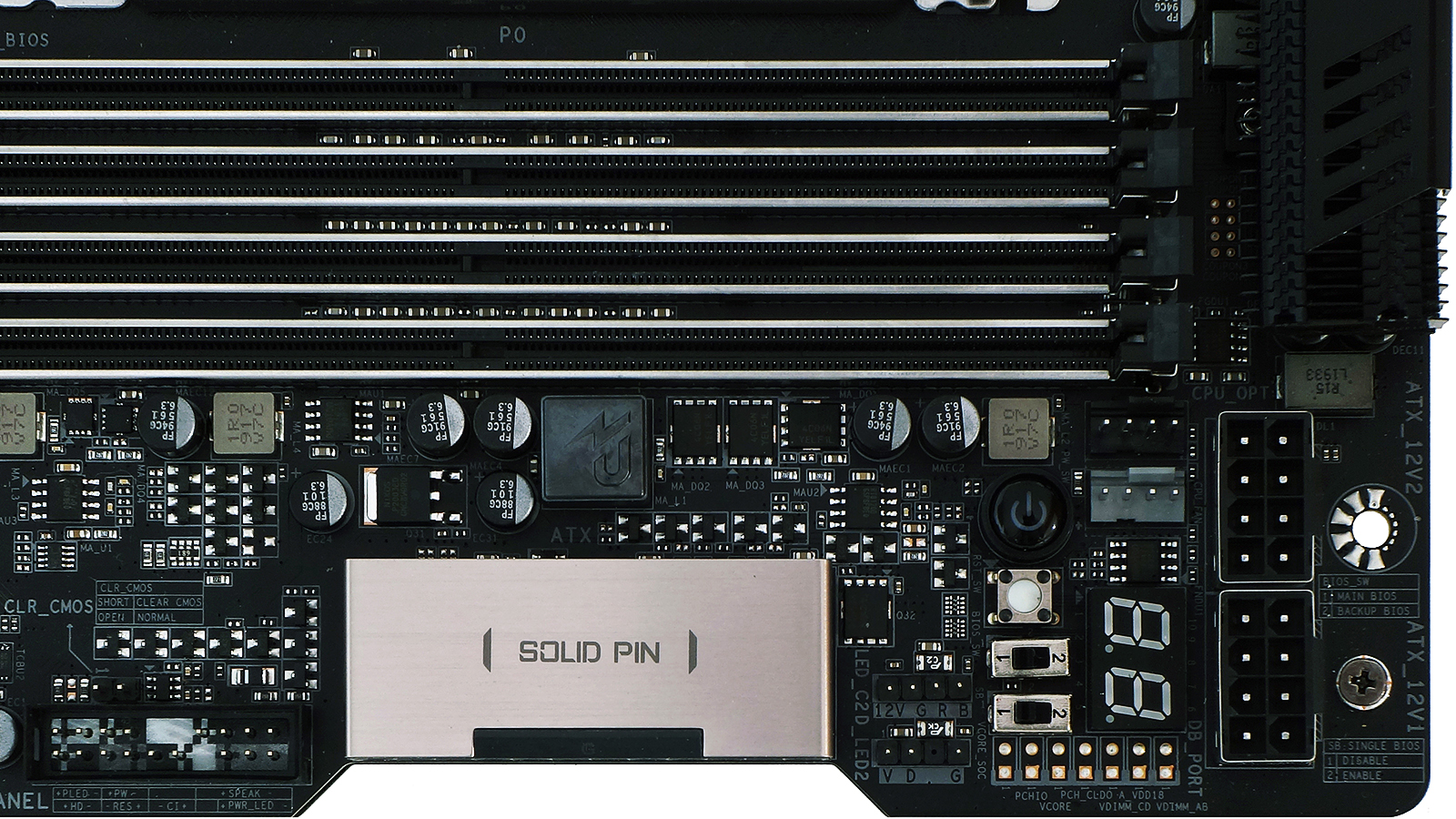
Two more fan headers are located in the Aorus Master’s top front corner, next to power and reset buttons, a two-digit status code display, jumpers to disable dual-BIOS mode and select the desired firmware IC, a second RGB cable header, and a second ARGB header.
Back plates are all the rage with reviewers, and they even help to gussy-up open-framed chassis. The TRX40 Aorus Master’s version is made of stamped, powder-coated aluminum sheet.
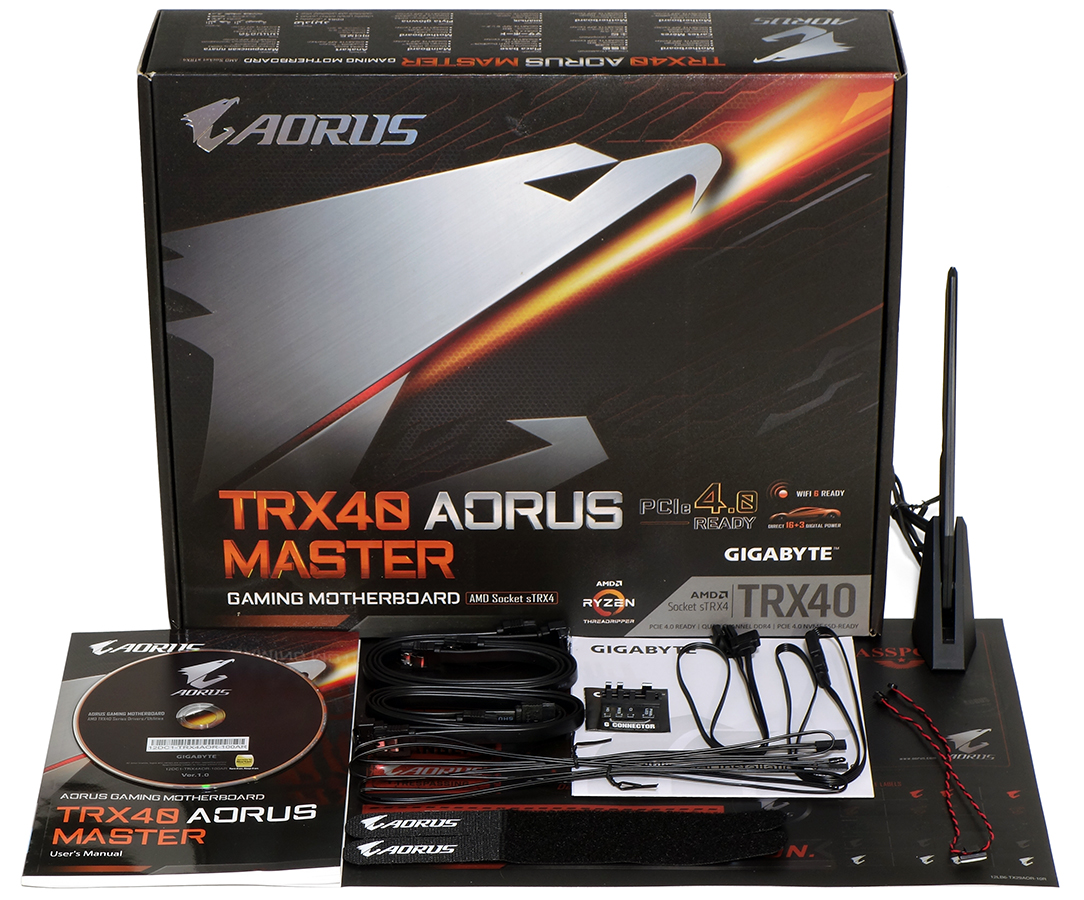
Gigabyte really knows how to fill a box, packing the TRX40 Aorus Master with a pair of thermistor cables, RGB extender and ARGB adapter cables, an internal remote microphone cable, G-Connector front-panel LED/button cable bundler, sticker pack and Velcro cable ties in addition to the expected four SATA cables, dual-band Wi-Fi antenna, drivers and application disc and manuals.
MORE: Best Motherboards
MORE: How To Choose A Motherboard
MORE: All Motherboard Content
-
noko Good review, as time goes on with newer bios etc. OCing I wonder if improved? As in when doing next TRX40 board, retest with the updated firmware would be much appreciated. A lot more work but only way to make articles worth it for a new buyer. Frankly I never had this hard of a time deciding which motherboard would best fit me. The Asrock Content Creator TRX40 board I also like but the VRMs are probably the weakest of all TRX40 boards but with good cooling, comes with 4 evenly spaced PCIe 16x slots, ATX, 10g land + 2.5g land. The only ASUS board I like is the Extreme but the price makes it not worth it. MSI? Would love to see some of these boards loaded up with GPU's, SSD's etc. to show the different configurations.Reply
